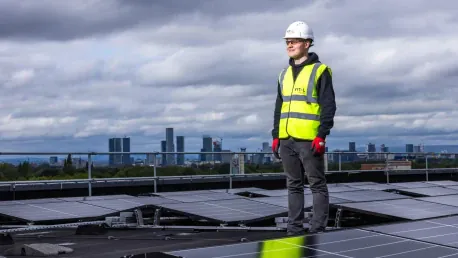Listen to the Article
The solar power industry has grown greatly in recent years thanks to policy backing, environmental needs, and technological breakthroughs. Primary growth has occurred in Europe and the United States, but it wasn’t without the emergence of new obstacles, including international trade disputes, political instability, and global supply chain adaptations. This article explores developments in the United States and Europe and looks at the impact of the Inflation Reduction Act. It also examines how global factors influence the future of solar energy.
Growth Fueled by the Inflation Reduction Act
In 2023, the solar industry in the United States was worth $64 billion. It now ranks among the most prominent business sectors in America. According to the Solar Energy Industries Association (SEIA), the United States now has over 10,000 businesses, employing about 280,000 staff members. Their yearly capacity installation reached 37.4 GW in 2023 while showing a significant 58% growth rate compared to the previous year. Analysts predict the field will maintain its rapid development by increasing its capacity to 45.5 GW during 2024, representing a 22% increase.
The Inflation Reduction Act (IRA), passed in 2022, is the primary catalyst for expanding the domain. The act provides $369 billion in funds to enhance clean energy projects, thus becoming the most considerable climate-focused legislation in US history. The Investment Tax Credit (ITC) for Sunlight-driven power within the document provides a 30% tax benefit that will stay available through 2032. Because of this tax incentive, the industry will remain dynamic in the United States for multiple years.
The positive outlook has several potential risks in the long term. As Republicans take more governance, this could lead to challenges against clean energy incentives. The political climate uncertainty holds back new projects because the market needs to observe the changing governmental situation.
According to Wood Mackenzie analysts, the solar market will maintain vigorous growth rates in the upcoming months. Many large utility-scale projects have received permits to access the power grid, which gives these projects temporary protection from any political changes that might happen in the near future. The stability of the market has improved because the cost of electricity from sunlight is now lower than that of traditional fuel sources.
The Global Ripple Effect of the IRA
The Inflation Reduction Act achieves price reductions for solar power while reshaping the worldwide production of photovoltaic systems. USA wants to build local energy manufacturing capacity by using financial opportunities in the new law, to reduce its reliance on imported products, especially from China and other nations. New investments in sunlight-fueled production facilities across America now help us rely less on foreign imports.
Beyond domestic borders, the Inflation Reduction Act generates many consequences. Because of this legislation, European nations and China must now review their existing policies. The United States wants to become a major player in photovoltaic production. This change will require other countries to adapt so they can stay competitive. Europe now faces rising pressure to defend its domestic solar manufacturers because they believe US efforts for production independence threaten their business interests.
European Union members have started an initiative to boost clean energy manufacturing after the passage of the Inflation Reduction Act. In 2024, the Net-Zero Industry Act (NZIA) was introduced with the objective of securing European producers for 40% of renewable energy equipment, including solar panels.
Europe’s Solar Expansion and Protectionism
Solar energy has experienced rapid development across Europe, reaching 56 GW in 2023, soaring by 40% from the previous year’s levels. Sun-powered system deployment is expected to keep accelerating because 2024 will bring 62 GW installations while showing continuous expansion after that year. Sunlight generated 9.1% of the total European electrical output in 2023 while demonstrating growing popularity since 2022’s 7.6%.
The rapid development of solar energy in Europe was driven by changes in the region’s approach to this type of technology in recent years. The European market discarded its previous protectionist measures, including tariffs and Minimum Import Price (MIP) schemes, during the latter part of 2018. Solar panels demonstrated increased expenses to developers due to the Minimum Import Price policy. Eliminating protectionist policies has reduced panel costs, allowing sunlight-sourced electricity to match traditional power generation prices across various European countries. However, prices have reached parity with conventional energy costs in recent times.
The recovery plan introduced by Europe specifically contributed to the growth of renewable sources. European Union members committed €750 billion to their stimulus plan in 2020, thirty percent of which was dedicated to fighting climate change. Clean energy projects, including photovoltaic systems, received increased support through this strategic plan.
Europe’s power sector faces a major problem because it relies on imports for its modules. Most of these imports come from China. Local manufacturers need European Commission protection through measures to prevent market price increases. The Net-Zero Industry Act seeks to support European producers but may raise prices when tariffs are imposed on lower-cost Chinese imports. European installation companies would face potential financial damage because they depend on inexpensive modules.
China’s Role and the Xinjiang Debate
The global photovoltaic industry significantly depends on China for its operations. In 2020, the worldwide production of solar-grade polysilicon totaled 45% because China dominated its manufacturing facilities. Most of this polysilicon material originates from the Xinjiang region, making it subject to rising political tensions. Xinjiang’s forced labor allegations have caused the US and other nations to impose trade restrictions on Chinese renewable technologies, particularly in the US market.
U.S. governmental authorities instituted restrictions on photovoltaic units sourced from Xinjiang territory, after which several corporations implemented protocols to verify that their supply networks were free from coerced labor. The agreement to prevent forced labor in supply chains has gained the support of more than 175 companies operating around the globe. The Solar Energy Industries Association (SEIA) has initiated a tracking system to follow solar panel materials according to US regulatory requirements.
Xinjiang-based Chinese polysilicon manufacturing lost its market share worldwide following the responses from other regions. Various locations have established new polysilicon production sites to respond to rising market requirements. Despite these challenges, forced labor concerns and the Xinjiang issue continue to influence global supply chain operations. The recent challenges have made the immediate effects of the restrictions less severe. However, these challenges have also put the growth of the renewable energy industry at risk.
Conclusion: A Path Forward for Global Solar Energy
Clean energy will maintain its rapid growth rate throughout the United States and Europe. Through its provisions, the Inflation Reduction Act establishes momentum for an increase in US solar production while minimizing equipment dependencies on imported materials. Europe is expanding its use of solar energy while facing challenges with local manufacturers. Despite these obstacles, the region is keeping costs low and maintaining a strong market for solar power. Concerns about labor issues in Xinjiang affect China’s ability to be a top solar power producer.
Current solar developments reflect multiple conflicting objectives, forming a decision path for future operations. Europe and North American governments seek more substantial production control of sun-based products at home as China handles diplomatic challenges stemming from its policy environment. Sun-sourced power is essential worldwide to fight climate change while promoting renewable energy adoption despite difficulties. The industry’s ability to transform according to these changes will establish its direction through the next few decades.









